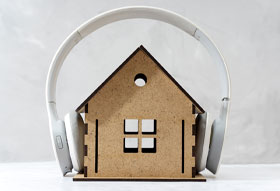
How to Soundproof a Wall with Foam

What is soundproofing and how does it work?
Soundproofing is the prevention of noise from entering or leaving a particular space, such as the home. It usually involves the use of foam blocks or wall panels to prevent sound travelling between spaces, although it cannot completely eliminate sound transfer. In the home, soundproofing would be used to prevent traffic noise from entering. Alternatively, it could be used between the adjoining walls of two semi-detached homes to prevent sound transfer.
Any form of soundproofing prevents the travel of noise by absorbing sound waves. Foam panels are used to physically block the sound waves from travelling, just like a barrier. Soundproofing foam is a specialist type of foam that is created for this purpose.
When you need to soundproof your wall
Soundproofing is a valuable investment if you are finding yourself disturbed by noise from loud neighbours. Given that most homes in the UK are terraced or semi-detached, soundproofing your adjoining walls is usually a worthwhile exercise!
Likewise, you may also be disturbed by noise elsewhere in your home. For those with home offices, soundproofing reduces the chance of being disturbed by footsteps, talking or slamming doors. Home office soundproofing can be as simple as a few foam panels on the wall, or can be more complex and advanced if audio recordings and telephone conversations regularly take place.
Two ways to soundproof a wall
Before soundproofing, you should determine whether the wall is an internal or external wall. For internal walls, you should consider using foam panels or installing a drywall soundproofing solution to prevent the transfer of noise, such as that generated by others talking. For external walls, there are a range of options including acoustic wool cavity insulation, foam acoustic membranes and other solutions such as fibreglass and specialist floor underlays to prevent the transfer of noise from the ground outdoors.
Your chosen soundproofing solution should consider the impact of sound escape, travel and reverberation within a space. A specialist will be able to best advise you on the most suitable solution.
How to use soundproofing foam for walls

Pre-cut soundproofing foam panels are very easy to install. You should begin by cleaning your wall area with sugar soap or a mild rubbing alcohol to ensure that nothing interferes with the adhesive. Measure your required area and ensure that your panel is the appropriate size. If you haven’t ordered this foam custom cut to size, a large craft knife or electric carving knife can be used to resize it.
Proceed to draw an outline of the panel(s) on the wall space and ensure the area is totally level. You should then use a simple spray adhesive on the back of the foam panel, ensuring that the total surface area is - for the most part - covered. You should leave the edges of the panel without adhesive in case you need to cut the panel again later.
You can place your foam panel straight on the wall with an adhesive spray glue. However, you should consider mounting it on cardboard first if you would like to reuse the panel at a later date, or if you are concerned about damage directly to the wall. The cardboard can then be fixed to the wall using command strips rather than spray adhesive.


